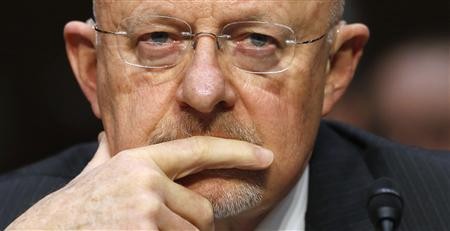New Syrian Terrorist Group Poses Greater Treat to U.S. Than ISIS
| Ren Benavidez | | Sep 22, 2014 11:02 AM EDT |
(Photo : REUTERS/KEVIN LAMARQUE) Director of National Intelligence James Clapper testifies before a Senate Intelligence Committee hearing on ''Current and Projected National Security Threats to the United States'' on Capitol Hill in Washington March 12, 2013.
Amid the threat of ISIL, a new Syrian terrorist group led by an affiliate of Osama bin Laden could pose a greater danger to the West, authorities and intelligence officials said.
According to the officials, the group, which called themselves Khorosan, was formed in 2013 and is set on launching terrorist attacks on the United States and its overseas installations.
Like Us on Facebook
Khorosan is reportedly led by a senior Al-Qaeda member, Muhsin al-Fadhli, who is said to be among the inner circle of Bin Laden and was included in planning of the 9/11 attacks.
The group is not as famous as the Islamic State, and not much is known about them.
However, according to intelligence officials, its members were formerly part of the Al-Qaeda from the Middle East, North Africa and South Asia. But other than Fadhli, other members of the group remained unidentified.
The group's mode of operation reportedly includes making use of concealed bombs.
In a statement released on Thursday, National Intelligence Director James R. Clapper said Khorosan posed a greater threat to the U.S. than the Islamic State.
According to experts on terrorism and national security, the issue on ISIS has overshadowed the greater danger of terrorism that has risen from the civil war in Syria.
In addition, they said Khorosan and the Nusra Front, which are traditional type of terrorists that branched out from Al-Qaeda, were more dangerous.
For over a decade, American intelligence operatives have been monitoring the movements of the 33-year-old Fadhli.
Following the Sept. 11, 2001 attacks, Fadhli moved from Afghanistan to Iran, where he stayed with other Al-Qaeda members, before he went to Syria, according to the U.S. State Department.
The State Department identified Fadhli as the leader of al-Qaeda in Iran in 2012, who ran and controlled the groups movement and funding within the country.
According to the Iranian government, the Al-Qaeda operatives stayed in the country under house arrest, but their living conditions have been disputed for years, and those who fled Iran went to different countries, including Syria and Pakistan.
TagsISIL, ISIS, syrian terrorists
©2015 Chinatopix All rights reserved. Do not reproduce without permission
EDITOR'S PICKS
-

Did the Trump administration just announce plans for a trade war with ‘hostile’ China and Russia?
-

US Senate passes Taiwan travel bill slammed by China
-

As Yan Sihong’s family grieves, here are other Chinese students who went missing abroad. Some have never been found
-

Beijing blasts Western critics who ‘smear China’ with the term sharp power
-

China Envoy Seeks to Defuse Tensions With U.S. as a Trade War Brews
-

Singapore's Deputy PM Provides Bitcoin Vote of Confidence Amid China's Blanket Bans
-

China warns investors over risks in overseas virtual currency trading
-

Chinese government most trustworthy: survey
-

Kashima Antlers On Course For Back-To-Back Titles
MOST POPULAR
LATEST NEWS
Zhou Yongkang: China's Former Security Chief Sentenced to Life in Prison

China's former Chief of the Ministry of Public Security, Zhou Yongkang, has been given a life sentence after he was found guilty of abusing his office, bribery and deliberately ... Full Article
TRENDING STORY

China Pork Prices Expected to Stabilize As The Supplies Recover

Elephone P9000 Smartphone is now on Sale on Amazon India

There's a Big Chance Cliffhangers Won't Still Be Resolved When Grey's Anatomy Season 13 Returns

Supreme Court Ruled on Samsung vs Apple Dispute for Patent Infringement

Microsoft Surface Pro 5 Rumors and Release Date: What is the Latest?










